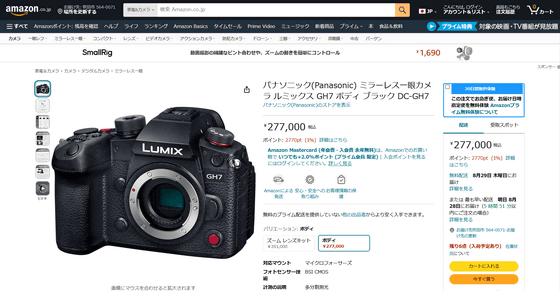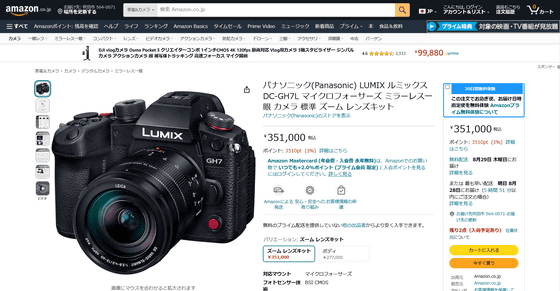How much has the autofocus of the GH7 improved compared to the GH6? And how about the phase detection AF and image stabilization systems? Comparative review

The ' LUMIX DC-GH7 ' released by Panasonic on Friday, July 26, 2024 is a mirrorless single-lens camera in the 'LUMIX GH' series that excels at video shooting. It is equipped with a 3/4-inch IMOS sensor and can shoot 4K/60fps video, and has undergone various improvements from the previous model GH6. In particular, it is the first in the GH series to support '
Overview Digital SLR Camera DC-GH7 | Digital Camera (LUMIX) | Panasonic
https://panasonic.jp/dc/products/DC-GH7.html
The following article compares the appearance and specs of the GH7 with the previous model, the GH6. You can see that the GH7 looks almost identical to the GH6.
I checked the appearance of Panasonic's mirrorless single-lens camera 'LUMIX DC-GH7' while comparing it with the previous model GH6 - GIGAZINE

Also, the following article provides some example photos to show you what kind of photos you can take with the GH7.
I tried taking various photos with Panasonic's mirrorless single-lens camera 'LUMIX DC-GH7', which has a wide dynamic range and a wide range of expression - GIGAZINE

◆Testing the GH7's improved autofocus with the introduction of phase detection AF
The GH7 looks almost the same as the GH6, but the image sensor has evolved from the GH6, adopting a back-illuminated CMOS image sensor with approximately 25.2 effective megapixels. Furthermore, while the GH6 had an AF system based on contrast differences, the GH7 is equipped with an on-chip phase difference sensor that quickly and accurately calculates the distance to the subject and captures the subject with 779 distance measurement points.
What has changed with this evolution is that the speed at which it takes to focus during autofocus has improved significantly. So, we actually compared the autofocus speed with the GH6.
Autofocus is set using the autofocus lever and the autofocus button in the middle of it. MF on the autofocus lever is 'manual focus,' C is 'AFC' which is suitable for shooting moving subjects, and S is 'AFS' which is suitable for shooting still subjects.

This time, to compare the GH6 (left) and GH7 (right), we attached them to

In the following movie, we compare the focus speed when changing the subject from 'a picture of a cat in the foreground' to 'a stuffed animal of iCEO in the background' with both machines attached to SLIK Plate III. As you can see from the movie, the GH7 is clearly faster in focus than the GH6, and you can see that the subject can be switched smoothly.
I compared the autofocus speed of the GH7 and GH6 by shooting simultaneously to see how much difference there is in the image plane phase difference AF - YouTube
In addition, the accuracy of the automatic recognition AF has been improved thanks to L2 Technology , developed in collaboration between the camera brand LEICA and Panasonic's LUMIX brand, and Panasonic's proprietary DFD technology (spatial recognition technology).While the GH6 could only automatically recognize people and animals, the GH7 can now also recognize 'fast-moving subjects' such as cars, motorcycles, trains, and airplanes in addition to people and animals.
Auto-detection AF can be enabled by selecting 'Auto-detection ON/OFF' on the autofocus settings screen.

The GH6's automatic recognition targets were 'people,' 'faces and eyes,' and 'animals + humans.'

Cars, motorbikes, trains, and airplanes have been added to the GH7. Also, human silhouettes, faces, and eyes have been grouped together under 'People,' and animals have been separated from people.

For example, if you set it to full area (automatic recognition), the camera will automatically recognize when a subject comes within the field of view and automatically adjust the focus.

For trains, you can choose from two target areas: the front car of the train, or prioritizing the main parts.

Below is a movie of a train actually sliding into the platform to test the GH7's automatic recognition AF. At first, the focus is on the pillar in front, but when the front of the train coming from the back is reflected, the focus is quickly set on the train.
I also set the GH7 to automatically recognize animals and tried taking a picture of a pigeon that was walking around in front of the station. In the second half of the movie below, the camera captures a pigeon on the other side of a fence, but the camera automatically focuses on the pigeon at the back, not on the fence in front. You can also see how the camera instantly focuses on a pigeon that flies off the fence and quickly chases after it.
Panasonic LUMIX DC-GH7's automatic recognition AF captures pigeons in the city - YouTube
◆Verification of the significantly improved image stabilization system in the GH7
Like the GH6, the GH7 is equipped with a 5-axis in-body image stabilization (BIS) that compensates for camera shake equivalent to 7.5 stops of shutter speed based on information obtained from the 'imaging sensor' and 'accelerometer' in addition to the signal from the 'ultra-high-precision gyro sensor.' When a Dual IS2-compatible lens is attached, a more powerful image stabilization system can be used by cooperating the OIS, a lens-shift type 2-axis image stabilization, and the BIS.
And for video shooting, the GH7 is the first GH series to implement active IS, making it possible to correct larger camera shake than ever before. In addition, the electronic image stabilization (EIS) is now equipped with a new video peripheral distortion correction function, reducing peripheral distortion when using a wide-angle lens. In addition to the 'standard' correction mode, a 'strong' mode has been added, making it possible to handle larger shakes.
The Micro Four Thirds lens used for this shoot , the GX VARIO 12-35mm/F2.8 ASPH./POWER OIS H-HS12035 , has a switch on its side for turning the Power OIS on and off.

Electronic image stabilization can be set from the video menu on the menu screen, as shown in the screen below.

'Electronic Image Stabilization (Video)' can be switched between 'Strong,' 'Standard,' and 'OFF.' This time, select 'Strong.' 'Image Stabilization Boost (Video)' is an image stabilization mode that is useful when shooting handheld with a fixed camera, and 'Anamorphic (Video)' is an image stabilization mode that is useful when shooting with

The GH6's image stabilization settings screen looks like this. Electronic stabilization (video) has only 'ON' and 'OFF' settings.

With the GH6 and GH7 attached to the SLIK Plate III, I tried handheld shooting without using a gimbal. The following movie was shot with both Power OIS and electronic image stabilization turned off, and it is clear that the photographer's movements are reflected in the screen blur to the same extent in both cases.
Comparison of footage shot while walking handheld with all image stabilization turned off on the GH7 and GH6 - YouTube
And here are the results of handheld shooting with the Power OIS switch on the side of the lens turned on and the electronic image stabilization turned off. When Power OIS is turned on, Dual IS is activated, so the effects of camera shake are reduced in both cases compared to footage shot with both turned off, but the GH7 has less blur than the GH6 thanks to the active IS.
Comparison of footage shot with Dual IS on and electronic image stabilization off on the GH7 and GH6 - YouTube
Furthermore, when shooting with electronic image stabilization turned on, the GH7 almost completely suppresses camera shake and distortion around the edges of the video, making the video so smooth that you would believe it was using a gimbal. The difference is clear when you watch the following movie compared to the GH6.
How much has the GH7's image stabilization improved? Compare it with the GH6 with both Dual IS and electronic image stabilization turned on - YouTube
However, when electronic image stabilization is turned on, the angle of view becomes slightly narrower, and the focal length is about 1.10 times wider when electronic image stabilization is turned on, and about 1.25 times wider when electronic image stabilization is turned on, compared to when electronic image stabilization is turned off. Therefore, if you are going to take handheld photos while walking with the image stabilization turned on, it is a good idea to use a wide-angle lens.
Next time we plan to check out the dynamic range and real-time LUTs of the GH7's video performance, so stay tuned.
Panasonic's LUMIX DC-GH7 can be purchased from Amazon.co.jp. The price for the body only is 277,000 yen including tax.
Amazon.co.jp: Panasonic Mirrorless Camera Lumix GH7 Body Black DC-GH7: Electronics & Cameras

In addition, a zoom lens kit including the lens 'H-ES12060 LEICA DG VARIO-ELMARIT 12-60mm / F2.8-4.0 ASPH. / POWER OIS' can be purchased for 351,000 yen (tax included).
Amazon.co.jp: Panasonic LUMIX DC-GH7L Micro Four Thirds Mirrorless Camera Standard Zoom Lens Kit: Electronics & Cameras

·to be continued
Related Posts:





